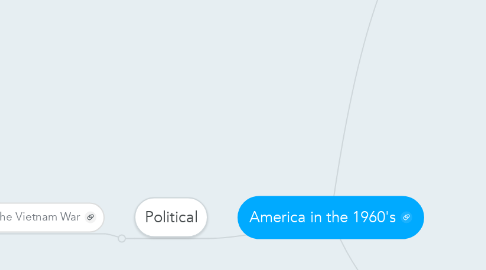
1. Political
1.1. The Vietnam War
1.1.1. Reactions to the war
1.1.1.1. On one side: Patriotic people, 'Middle America', farmers, veterans of the second World War and blue collar workers protested against the students
1.1.1.2. On the other side: Students protested against the war and their parents.
1.1.2. President Nixon
1.1.2.1. President Nixon promised that USA was done in the war, and wanted to send soldiers home. He didn’t. He continued getting US involved in the war. He started a big military operation against Vietnam.
1.1.2.2. After Nixon's promise, over 80% campuses declared strike. It was the re-birth of the anti-war movement: Now everyone joined. Old ones, young ones, conservatives. But, some got killed, and the courses closed early in the summer of 1970.
1.1.3. The Weathermen
1.1.3.1. The young activists who didn't stop protesting became the Weathermen. The Weathermen was an organization of activists. They killed people with bombs. Today we would call them terrorists, but they didn't back then. Carl (from the video) says, that the Weathermen did what they did because all legitimate politics had been destroyed by America.
2. Social
2.1. Jim Crow Laws
2.1.1. - Racial segregation - Black were treated like second-class-citizens
2.2. The african americans gained equal rights and were allowed to vote, but it was not granted (1870)
2.3. NAACP (National Association for the Advance of Colored People)
2.3.1. Their goals was: To challenge issues like the Jim crow Laws and to increase racial equality
2.3.2. Kennedy supported the movement and proposed a civil rights bill to congress, which was approved in 1964
3. Cultural
3.1. Counterculture
3.1.1. Their headquater was in the Haight – Asbury neighborhood in San Francisco
3.1.2. The movement wanted a more peaceful and tolerant world with equal rights for all in the elimination of the war. They questioned the Materialist system and spreader the Psychedelic drug.
3.1.3. The paradox: A lot of people wanted to end the world. And protested against it. At the beginning the protests were peaceful but got more and more aggressive. More and more puvlic hated the movement while more and more were joining the demonstrations. The society got SPLIT.
3.2. Timothy Leary
3.2.1. Quote: "Drugs is a good way to turn on, tune in and drop out"
3.2.2. Leary became the outspoken leader of a generation that wasn’t even his own
3.2.3. He was a clinical psychologist
3.3. The Hippies
3.3.1. There were three reasons to the popularity of the Hippies: 1. They got a lot of time in the media 2. They were very visible on the street 3. They were the town "criers" of some ideas, some values and some new lifestyles
3.3.2. There were some centeral values of the counterculture - Living free - Live as cheaply as possible - Love one another
3.3.3. A lot of teenagers were saying no to 'The American Dream' (a education, big house, money) and they were doing that by joining the hippie movement and leaving the society
3.3.4. "Whatever happens, happens" Was the cliché of the hippies. The things they did were so bazar that nothing was unusually.
3.3.5. The Woodstock festival was the highest point of the hippiemovement because it symbolized everything they stood for.
3.3.6. More than 3.5 million joined the communal life, but there were some downsides to this lifestyle. The Hippies were getting hepatitis because the flies were sitting on the food.
3.3.7. The Hippies survived because of 'foodstamps'
3.3.8. The hippie movement died because of absobtion by the main stream America life

